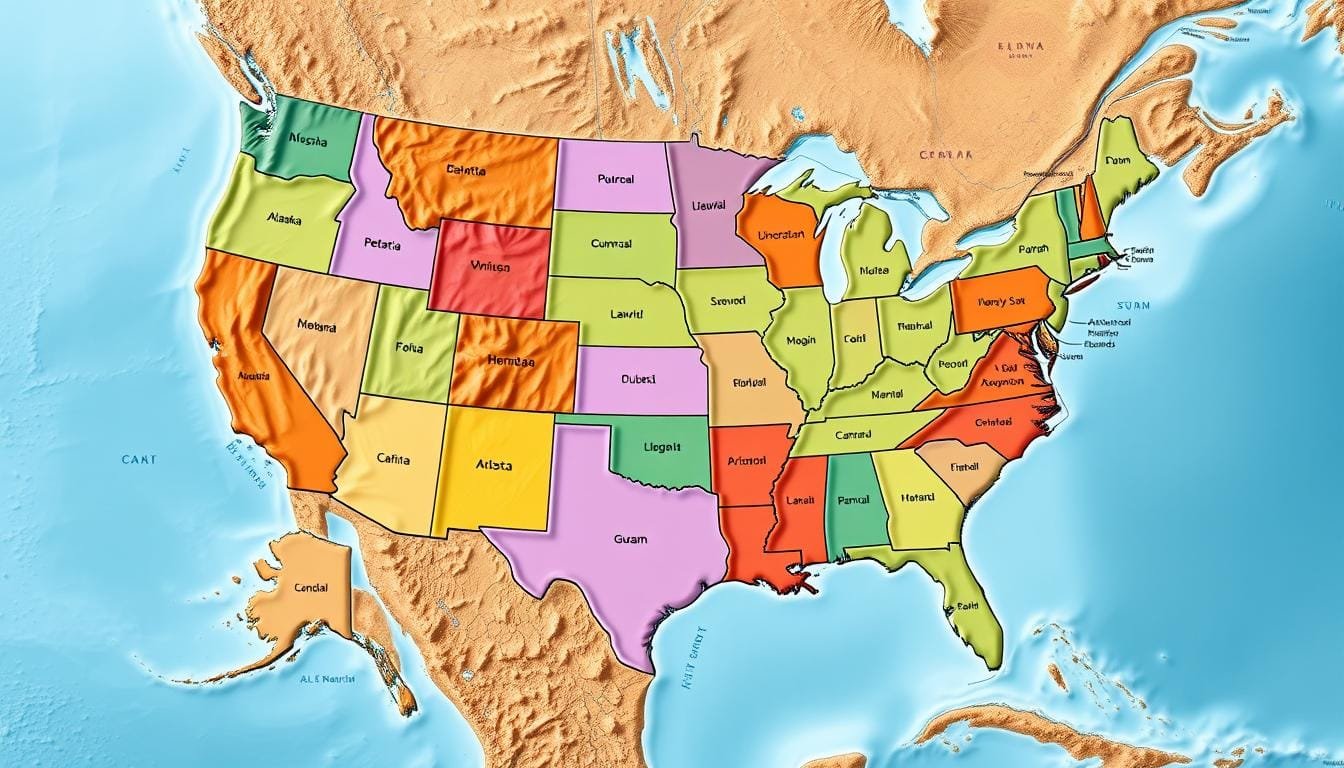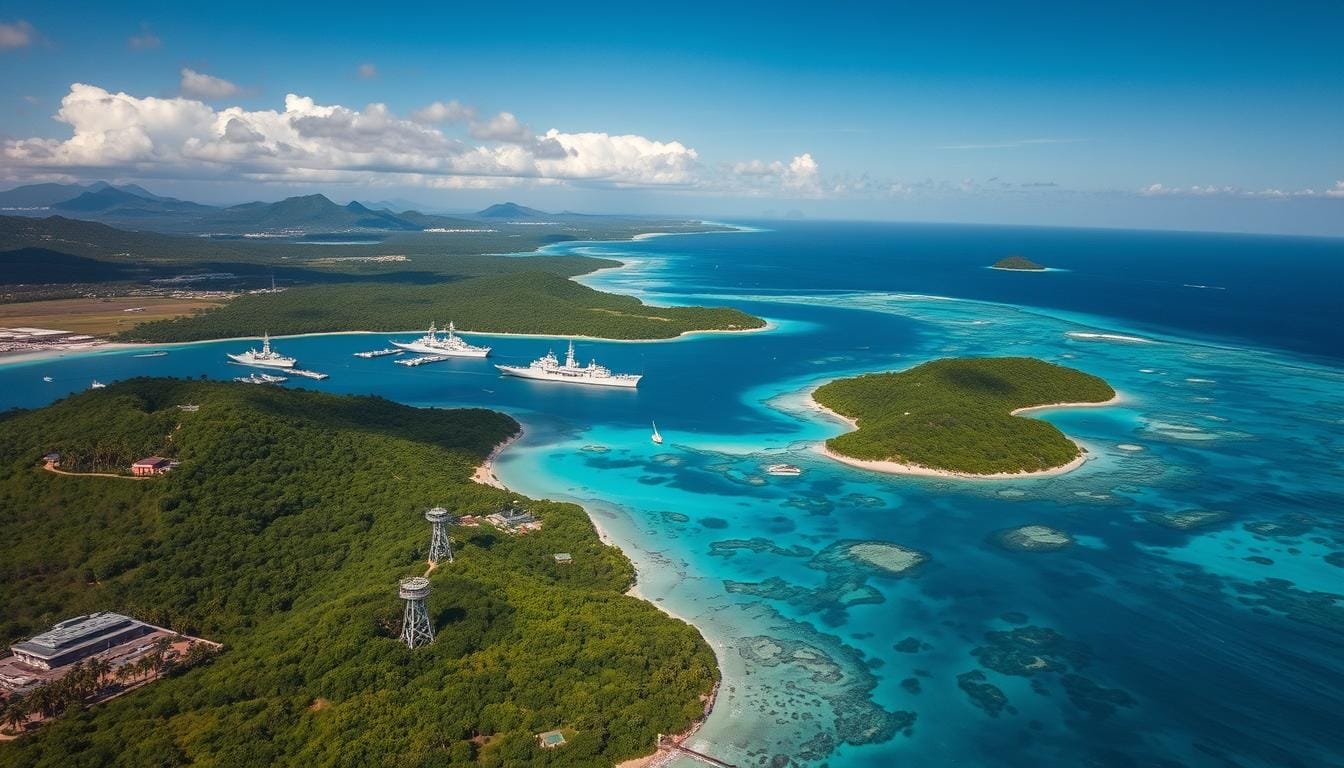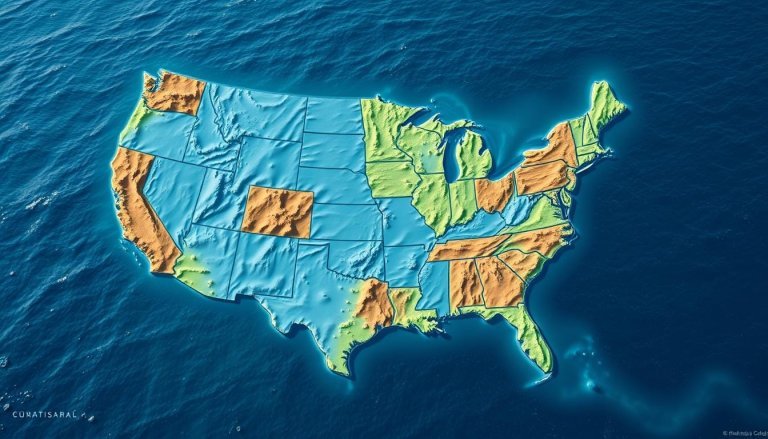The United States of America is more than just 50 states. It has a vast network of USA islands and American territories all over the world. These islands, from busy Caribbean spots to far-off Pacific atolls, are key to America’s geography and economy.
Did you know the U.S. has 14 overseas territories? These include famous places like Puerto Rico and hidden gems like Wake Island. This wide range of territories makes America’s economic zone the biggest in the world.
Let’s look at some interesting facts about these island territories. The 2022 Economic Census of Island Areas shows about 50,000 businesses in places like Puerto Rico and Guam. This census happens every five years and sheds light on the economic life of these territories.
Want to know about the smallest USA islands? The United States Minor Outlying Islands are nine tiny islands – eight in the Pacific and one in the Caribbean. Even though they’re small, these islands are important. Midway Atoll, the biggest at 6.2 square kilometers, was crucial in World War II.
Overview of US Territory and Island Possessions

The United States has a huge and varied territory. It includes the mainland and many island possessions. With 50 states, the US is the third-largest country by area.
The 50 States and Federal Districts
The US has 50 states and Washington, D.C. as the federal capital. It has over 334 million people. This makes the US very populated.
Understanding US Territorial Classifications
There are 14 overseas territories besides the 50 states. These territories have different levels of self-rule. Some examples are:
- American Samoa: An unincorporated territory with about 55,000 inhabitants
- Northern Mariana Islands: A US commonwealth since 1975
- Guam: An unincorporated territory in the western Pacific
- US Virgin Islands: Acquired from Denmark in 1917
- Puerto Rico: A US territory since 1898, now a commonwealth
Historical Acquisition of Island Territories
Many US island acquisitions happened after big historical events. Puerto Rico and Guam became US territories after the 1898 Spanish-American War. The US bought the US Virgin Islands from Denmark in 1917 for $25 million.
After World War II, the US got control over several Pacific islands. These include Baker, Howland, and Jarvis Islands. Now, they are wildlife conservation areas.
USA Islands: Major Inhabited Territories

The United States has many island territories beyond its mainland. These places have unique cultures and landscapes. Let’s look at the main inhabited US territories.
Puerto Rico: A Commonwealth in Transition
Puerto Rico is the most populous US territory. It has over 3 million people, making up 90% of US territory’s population. Puerto Ricans became US citizens in 1917.
The island has voted six times on its status. Recently, most votes were for statehood.
US Virgin Islands: Natural Beauty and Tourism
The US Virgin Islands were bought from Denmark in 1917. They are famous for their beautiful beaches and tourism. With 105,413 people, they became US citizens in 1932.
The islands mix Caribbean culture with American influence.
Guam: A Strategic Pacific Outpost
Guam is a key military base in the Western Pacific. It has nearly 200,000 people and US citizenship. Its location is crucial for US defense in the region.
Northern Mariana Islands: A Diverse Commonwealth
The Northern Mariana Islands became a US commonwealth in 1975. It has about 50,000 people and a mix of cultures. People born here got US citizenship in 1986.
American Samoa: Unique Status and Rich Culture
American Samoa has five volcanic islands and two coral atolls. It has 49,710 people and a special status as US nationals but not citizens. The territory is 77 square miles of land and has vast waters.
American Samoa has the highest military enlistment rate among US territories.
| Territory | Population | Year of US Citizenship |
|---|---|---|
| Puerto Rico | 3 million+ | 1917 |
| US Virgin Islands | 105,413 | 1932 |
| Guam | 200,000 | At birth |
| Northern Mariana Islands | 50,000 | 1986 |
| American Samoa | 49,710 | N/A (US Nationals) |
Pacific Remote Islands and Atolls
The United States Pacific Remote Island Area (PRIA) has seven islands, atolls, and reefs. They cover a huge area in the central Pacific Ocean. Each place is special and has its own history.
Baker and Howland Islands
Baker Island and Howland Island are home to wildlife. The U.S. claimed them in 1856. Now, they’re part of a marine national monument, protecting the sea life.
Johnston and Wake Islands
Johnston Atoll was once a military base. Now, the Department of Defense manages it. Wake Island is still a U.S. Air Force base. It’s home to many fish and coral species. Both islands were important in World War II.
Palmyra Atoll and Kingman Reef
Palmyra Atoll and Kingman Reef are in the marine national monument. They support seabirds and have many corals. Palmyra Atoll even has a runway for planes.
Midway Atoll and Its Historical Significance
Midway Atoll is famous for its World War II battle. It’s now a wildlife refuge. The atoll is home to many seabirds and has a working airstrip.
| Island/Atoll | Status | Management | Notable Features |
|---|---|---|---|
| Baker Island | Uninhabited | USFWS | Wildlife refuge |
| Howland Island | Uninhabited | USFWS | Wildlife refuge |
| Johnston Atoll | Former military base | DOD | 45+ coral species |
| Wake Island | Active military base | DOI/USAF | 300+ fish species |
| Palmyra Atoll | Protected | USFWS | Serviceable runway |
| Kingman Reef | Protected | USFWS | High coral diversity |
| Midway Atoll | Wildlife refuge | USFWS | Historical significance |
Strategic and Environmental Importance of US Island Territories
US island territories are key to America’s global strategy and protecting the environment. These islands in the Pacific and Caribbean are important for both military bases and wildlife refuges. They help keep the country safe while also protecting nature.
Guam is a prime example of how important these territories are. It’s called “the tip of the spear” because it’s a big military base. About 9,700 military personnel live there, which is 14% of the island’s people.
In 2022, the Defense Department spent $2.5 billion in Guam. This was 41% of the island’s GDP. A new $7.3 billion plan for military construction and $1.7 billion for missile defense shows Guam’s big role.
Having military bases brings jobs and money, but it also harms the environment. The US government tries to fix this by creating marine national monuments and wildlife refuges. These places protect special ecosystems and animals, keeping the territories’ biodiversity safe.
| Initiative | Funding | Purpose |
|---|---|---|
| USAID Microfinance Facility | $50 million | Support Pacific MSMEs |
| Pacific Resilience Facility | $20 million | Enhance regional resilience |
| Tuvalu Coastal Adaptation Project | $2.65 million | Climate change adaptation |
| Disaster Preparedness | $3.6 million | Improve Pacific disaster readiness |
The Biden-Harris administration is working hard with Pacific Island nations. They’ve had summits and opened new embassies. This shows how valuable these territories are, not just for the military.
Conclusion
The US island territories are key to American power, spread across the Pacific and Caribbean. Places like Puerto Rico and Palmyra show the rich cultures and nature under US care. They are vital for defense and influence.
Protecting nature is a big deal for these islands. The US works hard to keep places like Palmyra Atoll safe. This shows the fight to save nature in these distant lands.
The status of some islands is still up for discussion. Yet, their role in America’s global reach is clear. Guam’s military base and the US Virgin Islands’ culture enrich America. Understanding these islands is crucial for seeing America’s global role.



